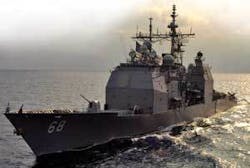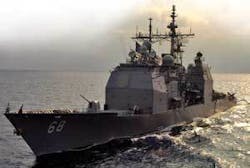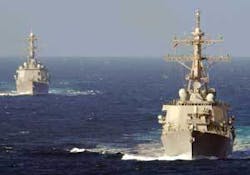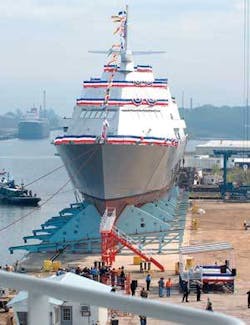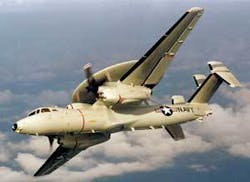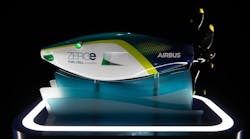Navy pushes smart engineering and open-systems architectures for the shipboard electronics and electro-optics aboard the nation’s combat fleet.
By Edward J. Walsh
U.S. Navy leaders achieved significant progress in shipbuilding and in integrating systems for new and fielded ships and submarines in 2006, even while they assumed demanding new missions.
In August the Navy released a memorandum that identified new roles for naval forces in homeland security and the global war on terror. Signing the memorandum, entitled “Department of the Navy Objectives for 2007,” were Navy Secretary Donald C. Winter, Chief of Naval Operations Adm. Michael Mullen, and then-Commandant of the Marine Corps Gen. Michael Hagee.
The guidance also placed new focus on special Navy workforce skills, including medical, explosive-ordnance disposal, heavy construction, reconnaissance, and special operations. It broadened the Navy’s 2007 roles beyond traditional sea-service missions by calling for new emphasis on ethical conduct for Navy management and safety in Navy-Marine Corps operations.
Yet the leadership also stipulated that the Naval services “build for tomorrow” by stressing the Navy-Marine Corps strengths of access, persistent presence, small footprint, and the need for a shipbuilding plan that wins consensus among the Bush Administration, Congress, and industry to “build the required number of ships.” Mullen has established a target of 313 battle-force ships for the fleet by 2012, an increase from 278 in late 2006.
The fiscal year 2007 defense budget, approved by Congress in September 2006, funds the Navy’s shipbuilding and conversion line at $11 billion for seven ships: the first two new Zumwalt-class DDG-1000 land-attack destroyers, two Freedom-class (LCS-1) littoral combat ships, a Virginia-class attack submarine, an amphibious assault ship, and a cargo ship. Navy leaders say they hope to get approval for seven more ships in 2008-including the first next-generation CVN-21 aircraft carrier-and for 11 ships in 2009.
DDG-1000
The DDG-1000 and LCS programs achieved critical development milestones in 2006. The Navy’s industry partners also achieved important progress in the integration of commercially developed technology for ship combat systems, new weapon and command-and-control systems, and shipboard power management and distribution.
In early August, the Naval Sea Systems Command (NAVSEA) awarded General Dynamics’s Bath Iron Works in Bath, Me., a $115.8 million contract for detail design and procurement of vendor-furnished information for the DDG-1000 program. The contract, which will include a study of ship zone detail, could be worth more than $336 million to the company if all options are exercised.
On Aug. 10, Bath awarded a contract valued at $186 million to DRS Technologies in Parsippany, N.Y., to develop the components of the DDG-1000 electric-power distribution system, called the Integrated Fight Through Power System (IFTPS), which will be adapted for an advanced induction electric motor and motor controller built by Alstom Power Conversion in Levallois, France.
The IFTPS is a measured step toward the Navy’s goal of incorporating for DDG-1000 an integrated electric-drive power system that had to be deferred when the DRS primary motor candidate, a permanent magnet motor developed by its business unit in Hudson, Mass., formerly Kaman Electromagnetics, experienced reliability problems.
In September NAVSEA awarded Northrop Grumman Ship Systems in Pascagoula, Miss., a $95.9 million detail design contract that also funds provision of vendor-furnished information, advanced zone detail design, and maintenance of the DDG-1000 integrated data environment. The Northrop Grumman contract could be worth more than $307 million for total detail design. The Navy plans to build the DDG-1000 using a dual-lead-yard arrangement, in which Northrop Grumman and Bath each will build ships concurrently. The lead ship, the USS Zumwalt, is scheduled for delivery in 2012.
The DDG-1000 is the ship class designation selected in April for a new-ships program formerly called DD(X) to build a “family” of ships that includes the new destroyer, the LCS, and a future cruiser called CG(X).
The DD(X) program aimed initially construction of as many as 24 destroyers, to be armed with an advanced gun system and a vertical launch system for long-range land-attack missiles for fire support for Marine Corps and Army units operating ashore. The current five-year defense plan (FYs 2006 through 2011), though, funds only five destroyers. Of the $11 billion 2007 shipbuilding budget, $2.6 billion is designated for two DDG-1000s.
Some Navy and industry officials believe that funding constraints may limit the DDG-1000 build to only the two lead ships, which would serve as demonstration platforms for technologies to be adopted for the CG(X).
In December 2006 the Navy exercised a $208 million option to a contract awarded to Bath in October 2005 for construction of one LCS, the second to be built by the company. The first Bath ship, Independence (LCS-2), is being built at the Austal USA Shipyard in Mobile, Ala.
A team led by Lockheed Martin’s Maritime Systems and Sensors business unit in Moorestown, N.J., and Marinette Marine in Marinette, Wis., also is building two LCSs; the first, the USS Freedom, was christened in September 2006.
Shipbuilding and associated costs have persisted. In early January 2007 the Navy issued a 90-day stop-work order to Lockheed Martin on its second LCS, being built at Bollinger Shipyard in Lockport, La. The Navy said that the stop-work was prompted by “significant cost growth currently being experienced” with the LCS-1 and LCS-3.
Mullen’s goal of adding combatant ships confronts at a time of tightly constrained budgets depends heavily on achieving major breakthroughs in the integration of costly ship systems through innovations in inserting commercial technology.
Open architecture
For new and fielded ships, the critical baseline is a Total Ship Computing Environment Infrastructure (TSCEI), to be based on compliance with the Navy’s Open Architecture (OA) vision, initiated in the late 1999s.
The open-architecture effort is intended, through a series of software builds, to provide a common software baseline for nearly all surface-ship combat systems functions. Rear Adm. Michael Frick, Program Executive Officer for Integrated Warfare Systems (PEO IWS), in a December 2006 briefing, described the open-architecture initiative as an enabler of combat systems “neck-down,” whereby the historically noninteroperable combat systems of all the Navy’s surface combatants will be replaced by a common combat-system family based on reusable and easily upgradeable commercial technology and close adherence to accepted commercial standards.
The open-architecture effort started in the late 1990s in an attempt to overcome the costs and management complexities of developing and supporting several combat systems for the Navy’s cruisers and destroyers, aircraft carriers, and amphibious assault ships. Most of those systems were based on Navy-unique computer hardware and software. The fielded Navy-unique systems also rapidly were becoming inadequate to meet new performance requirements without unaffordable upgrades.
The “spaghetti code” software architecture of the Aegis combat system aboard Ticonderoga-class (CG-47) cruisers and Arleigh Burke-class (DDG-51) destroyers, in which Navy-unique CMS-2 software was tightly integrated with an obsolescent computer hardware architecture of UYK-43 and UYK-44 computers, became impossible to modify without causing unwanted impacts throughout the system.
Kathy Emery, acting chief engineer for PEO IWS, told an Object Management Group technical conference in December that the “Naval OA core principles are modular design and design disclosure; reusable application software; interoperable joint warfighting applications and secure information exchange; life-cycle affordability; and increased competition and collaboration.”
Open-architecture implementation, she said, will reduce the time needed to field systems and upgrades, improve combat-system interoperability, reduce risk, and avoid high development costs.
An open-architecture computing environment (OACE) is the baseline for Navy OA technology insertion for each ship type. Combat-systems functionality, based on application software modules developed by the Navy’s combat-system integrators, primarily Lockheed Martin and Raytheon, is introduced through five “categories” of increasing capability.
Open-architecture categories 1 and 2 represent current fielded systems; categories 3 and 4 are now being fielded or are in development. Category 5, expected around 2015, will produce a TSCEI reflecting system-wide automation and maintenance-free performance. Ship- and systems-design software is maintained for reuse in an OA Software-Hardware Asset-Reuse Enterprise (SHARE) repository. The SHARE serves as a vehicle for potential vendors to gain access to Navy and contractor needs for systems design.
In early January, General Dynamics Advanced Information Systems (AIS) in Arlington, Va., delivered to the SHARE an Open Data Model for its LCS program. The nonproprietary Open Data Model allows other companies to offer components for use in the program that meet the specifications of the model.
Separate OACEs for the surface combatants (Ticonderogas and Burkes), carriers, amphibious assault ships, and auxiliaries will dovetail to produce the common combat system family that will be fielded for the future carrier class (CVN-21); CG-X; the LCS; an LHA replacement class that will replace the aging Tarawa-class (LHA-1) amphibious assault ships; and the Coast Guard’s Deepwater national security cutter.
PEO IWS is the lead office for the Naval Open Architecture Enterprise. In November 2006 the PEO released version 1.1 of an Excel-based open-architecture assessment tool, or OAAT, that will generate “quantifiable estimates” for use in determining the “openness” of Navy and Marine Corps systems.
The PEO said that openness provided through the OAAT refers to “both technical and business characteristics of a program that support modular design, easy interoperability with other systems, extensive employment of commercial standards, enhanced competition for development and support, and facilitates rapid technology insertion.”
Also in November, Raytheon Integrated Defense Systems in Tewksbury, Mass., prime contractor for the DDG-1000 mission system equipment, delivered a set of TSCEI specifications and design documents, source code, and user guides, designated Release 4.1, for the DDG-1000 TSCEI. In December IDS completed a successful review of the DDG-1000 ship control system design, including compliance with the DDG-1000 total ship computing environment and OA standards.
Raytheon IDS also is prime for the Ship Self-Defense System (SSDS Mk 2), the combat system planned for carriers and amphibious assault ships. In June 2006 the company tested an OACE Category 3-compliant version of the SSDS, consisting of commercially developed routing, switching, and processing components.
The SSDS Mk1 is aboard Whidbey Island-class amphibious assault ships. The Mk 2 variant was installed first aboard the Nimitz-class carrier Ronald Reagan (CVN-75) in 2002.
IDS says that the Category 3 SSDS will go through additional development testing, aiming at full production starting later this year, and initial deliveries to the Nimitz (CVN-68), San Antonio (LPD-17), and LHA-6, the first ship of the new LHA replacement program.
Lockheed Martins Maritime Systems and Sensors, prime contractor and systems integrator for the Aegis combat system aboard Ticonderogas and Burkes, says that the system eventually will adopt OA standards in tandem with software development for the Navy’s ballistic missile defense (BMD) system. The Aegis system now is fielded in a series of software baselines that provide increasing levels of capability.
Because of the anticipated complexity of simultaneously upgrading the Aegis baselines for open-architecture and developing the BMD capability, the Navy and the company decided to pursue both separately. The BMD work starting with the mature baseline 5 phase 3, while the baseline upgrade completed baselines 7 and 7 phase 1, which was certified in late 2005.
In March 2006 the Navy awarded Lockheed Martin a contract to start software development for Aegis baseline 7 phase 1C for the cruiser modernization program, with the new baseline to provide open-architecture compliance, the BMD capability, and commonality with the LCS and the Coast Guard’s Deepwater cutter.
Ticonderoga modernization
The Navy’s 22 Ticonderogas will go through the modernization, beginning with the USS Cape St. George (CG-71). The first five ships of the original Ticonderoga class, CGs-47 through CGs-51, which were not fitted with the Mk 41 vertical launch system and so were not BMD-capable, have been decommissioned, and one of them, Valley Forge, was sunk last year as a target.
Lockheed Martin has developed a ballistic-missile-defense signal processor (BSP) intended for integration with the Aegis SPY-1 phased-array air-defense radar aboard the Ticonderogas and Burkes to be designated for the ballistic missile defense mission. The BSP, to be fielded beginning in 2010, has gone through several successful at-sea tests. It will provide the target-discrimination processing function to identify through complex clutter a ballistic missile approaching at extremely high speed.
Company officials say that, depending on the availability of funding, the BMD effort and the Aegis baseline evolution could dovetail as early as 2012 in an open-architecture configuration.
Mercury Computer Systems of Chelmsford, Mass., has supplied Lockheed Martin with its Power Stream 7000 multicomputer for integration with the Aegis system for BMD processing.
The company says that the 7000, with more than a teraflop of memory, is based on a heterogeneous architecture of Power PCs and field-programmable gate arrays (FPGAs) that divide the combat-system processing tasks.
Mercury partner development director Joey Sevin says that such heterogeneous designs are becoming more common. “People are getting over the fear of programming multiple types of processors in the same system-they’ve realized that it’s basically managing the data movement,” he says.
Heat also is a major concern for tighter “multicore” processing architectures, which increase heat levels per individual processor. Mercury has patented a cooling technique for the Power Stream 7000 called “finely managed air” that the company says provides needed air flows across critical processor elements as necessary.
Mercury points out that the proprietary Navy-unique computing architectures of 10 to 15 years ago evolved towards commercial off-the-shelf, primarily VME-based technology. In recent years, Navy architectures have moved to the use of several racks of varied types of processors to perform a wide range of tasks.
Software tools needed to support interoperability also are improving, the company says. Mercury’s real-time embedded multicomputer operating system, which enables Power PCs to communicate with FPGAs, also is evolving towards use of Linux.
Sevin says that one of the major challenges of the shift to open-architecture is “when you can do it and when you can’t. As you get closer to the sensors, you have to go to real-time-when you need mission-critical real-time processing.”
Open Architecture Track Manager
In December, General Dynamics’s AIS won a $9.3 million Navy modification to a contract awarded in March 2005 for system integration, design, and leadership of an industry team for development of an Open Architecture Track Manager (OATM) functionality for shipboard combat systems open architecture for track management and sensor netting.
The company says that the OATM will be a software tool that creates an integrated picture of the locations and direction of aircraft, ships, and submarines across the battlespace. The General Dynamics OATM team includes Northrop Grumman, SAIC, and Lakota Technical Solutions.
The Office of Naval Research (ONR) is sponsoring an innovative effort, initially targeted for the DDG-1000, to develop a multifunction electronic warfare (MFEW) system. The work builds on ONR work started in the mid-1990s on an advanced multi-function radio frequency concept (AMRF-C) aimed at consolidating shipboard antenna apertures for radar, communications, and electronic warfare in order to counter the proliferation of arrays aboard newer surface ships. An AMRF-C test suite consisting of a common aperture and below-deck processing equipment has gone through demonstration testing at the Naval Research Laboratory’s Chesapeake Bay test range.
The MFEW initiative will configure the electronic surveillance (ES) component of the AMRFC to meet the ES requirement for the DDG-1000, which faced an urgent requirement for ES capability following the termination in 2002 of an advanced integrated electronic warfare system (AIEWS) originally planned for the new class.
Northrop Grumman Electronic Systems Sector won a contract to build an MFEW advanced development model, which will go through factory acceptance testing in May.
The MFEW ADM will be delivered to the AMRF-C site at Chesapeake Bay for testing this summer prior to transition to the Navy’s DDG-1000 program-management office for the system design and development phase beginning in 2008.
Integrated Topside INP
In a separate but related effort, ONR is developing an Integrated Topside Innovative Naval Prototype (INP) that builds on the AMRF-C, but aims to allocate available RF bandwidth among radar, communications, and EW, “treating RF as a resource,” ONR officials say.
The effort initially will aim at developing a common aperture for lower-power sensors, like navigation radars. Higher-power systems, like the volume-search radar (VSR) and multifunction radar (MFR), both going aboard DDG-1000, will continue to use dedicated apertures.
The Integrated Topside INP currently is set to start in 2009, but ONR is hoping to accelerate the schedule. The National Defense Industry Association sponsored an Integrated Topside industry day in November attended by a mix of industry and Navy officials. ONR plans to issue a request for information (RFI) in early 2007.
The INP is required to comply with the open-architecture initiative. ONR is looking at CG(X) as a potential platform, with the Integrated Topside technology demonstrated initially for satellite communications arrays.
The integration of ship combat systems for fleet operations, including joint-service theater-wide air defense, also will be based on new roles for the Navy’s cooperative engagement capability (CEC), developed and built by Raytheon Network Centric Systems.
The CEC fuses air-search radar target data from several ship and airborne CEC participants to create a common target picture shared in real time by all units on the network. CEC now is fielded to 47 ships in a USG-2 variant: eight aircraft carriers, 29 cruisers and destroyers, and 10 Wasp-class amphibious assault ships, and in an airborne design (USG-3), to 32 E-2C Hawkeye and one P-C3 surveillance aircraft. Army Patriot batteries and Marine Corps air-defense units have used CEC demonstration units.
Raytheon says that the Navy has identified a requirement for an additional 211 CECs, mostly for a remanufactured Hawkeye, the E-2D, but also for the DDG-1000, LCS, the Aegis cruiser modernization, San Antonio-class (LPD-17) amphibious assault ships, and roughly 25 for the Marine Corps. The company has received funding to start integration for the first two DDG-1000s.
The shipboard CEC is integrated with the Aegis system aboard the Ticonderogas and Burkes and interfaces with the SSDS for the carriers and amphibious assault ships. The system consists of a cooperative engagement processor (CEP) that carries out the sensor-fusion function, a data-distribution system (DDS) that transmits and receives sensor data among network participants, and a new planar array assembly antenna. Sensor data received by the ship and E-2 air-search radars is fused with data acquired from other ships to produce a single coherent air target picture.
Navy and Raytheon officials say that CEC provides the sensor-netting capability to establish a single integrated air picture (SIAP) critical for joint-service “network-centric warfare” by all the services. CEC has been demonstrated extensively in joint-operations exercises, but until the JLENS contract, the other services have been unwilling to field it themselves.
In late 2006 Raytheon won a Navy contract through the PEO IWS and funded by the Army for software development to integrate CEC system with new radars being developed for the Joint Land-Attack Cruise Missile Defense Elevated Netted Sensor System (JLENS).
The JLENS, a joint-service initiative managed by the Army, will consist of moored aerostats fitted with long-range radars. When maintained at altitudes around 15,000 feet, the JLENS radars will extend the wide-area netting of sensors for joint-service cruise missile defense.
Raytheon has completed a number of CEC product improvements to cut costs by inserting new processing technology. The CEC planar array antenna, now still being introduced, replaces a more expensive circular array that could not provide full 360-degree coverage on carriers. The company has introduced advanced transmit and receive array technology, and is redesigning the transceiver for the airborne variant.
The Navy has awarded a contract to Sechan Electronics of Lititz, Pa., to provide a new CEC signal data processor to replace several processor components of both the shipboard USG-2 and the airborne USG-3. Raytheon will integrate the SDP with the CEC system for both shipboard and airborne configurations for system testing and delivery to the Navy.
In ship machinery developments, the Navy remains committed to shifting the combat fleet, including carriers and submarines, to integrated electric drive, a concept that would eliminate expensive generators and the shaft-mounted reduction gears that control the flow of power to the propeller.
Power-conversion modules
DRS Technologies, under its August 2006 contract from General Dynamics/Bath for the IFTS development for DDG-1000, will design, develop, test, and build six shipsets of power-conversion modules that condition, amplify, and process power for the propulsion plant and ship systems. The company announced on Aug. 30 that it subsequently won several Navy contracts for production of advanced instrumentation and controls, power conversion modules, and other equipment for DDG-1000, LCS, and the CVN-78 next-generation carrier.
The DRS IFTS will be integrated for DDG-1000 with the Alstom Power Conversion 15-phase advanced induction motor (AIM), also selected by the U.K. Royal Navy for its new Type 45 Daring-class destroyer and the RN’s new aircraft carrier program. DRS IFTS components and the AIM have been tested extensively at the Naval Surface Warfare Center Carderock division’s land-based test site in Philadelphia.
The Naval Sea Systems Command and Anteon Corp. meanwhile are coordinating the work of several design review teams that are looking at industry ideas on technologies for the CG(X) that potentially could cut costs by improving performance and reducing size and weight of the ship’s power system.
Also aiming at CG(X), the Power Systems Group business unit of L3 Communications’s SPD Technologies company has developed a software-controlled quiet propulsion motor drive that the company says will enhance motor performance by eliminating harmonics, the electrical “noise” that often is fed back into power distribution system.
PSG has delivered a 500-kilowatt demonstration unit to the Naval Surface Warfare Center’s Carderock Division’s land-based test site in Philadelphia, where the unit will be tested with a motor. If the tests go well the company will build a full-scale 6.5-megawatt unit, which can be scaled up to work with any size Navy shipboard motor.
The PSG drive potentially also could interface with a 36.5-megawatt high-temperature superconductor propulsion motor being developed by American Superconductor Corp. under a $5.3 million Navy contract awarded to AMSC in October 2006. The company now is working on the motor, drive, and electrical system to configure the system for integration with the DDG-1000 or CG(X).
The superconductor motor development is based on several earlier Navy awards to the company for superconducting motors. The work, company and Navy officials say, recognizes the promise offered by high-temperature superconducting motors over earlier low-temperature superconductor-powered motors, which required sizable cryogenics equipment aboard ship.
